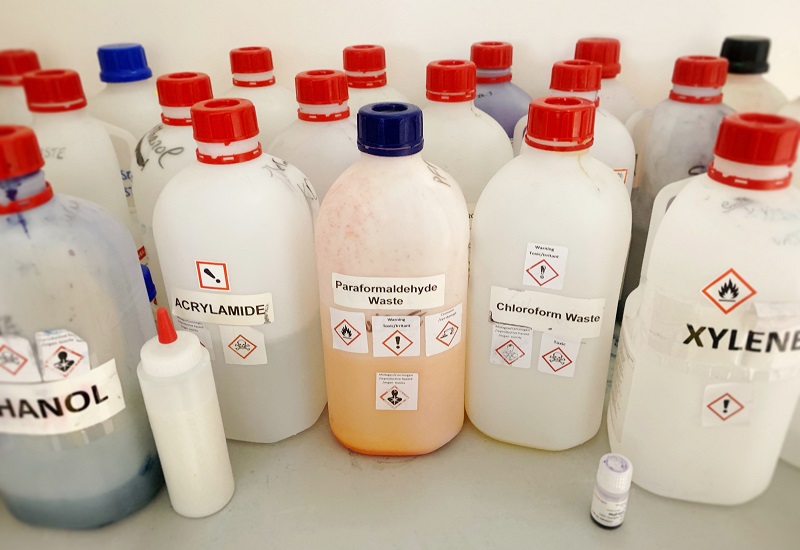Spillage of hazardous materials and flammable liquids can threaten the safety and health of workers, animals, property, and the environment. This is why the OSHA chemical storage and handling requirements are so rigorous.
There are three main OSHA chemical storage requirements. These are:
- each chemical and flammable liquid needs an accompanying Safety SDS Sheet (SDS) listing its toxicity, flammability, acidic or caustic properties – this includes how the substance reacts to fire, accidental exposure, and how spills are treated,
- the SDS has to be stored somewhere easy to reach when needed, and
- a documented training plan for employees handling these chemicals and flammable liquids, detailing training sessions on specific dates, must be maintained.
For a complete breakdown and detailed compilation of everything you need to know, keep reading.
What Does OSHA Consider a Hazardous Chemical?
Any chemical substance that can be hazardous to occupational safety and health is considered dangerous.
Hazardous chemicals include:
- explosives,
- gases,
- oil-filled equipment,
- flammable liquids,
- flammable solids,
- oxidizing agents and organic peroxides,
- toxic and infectious substances,
- radioactive substances,
- corrosive substances,
- asbestos
These chemicals are hazardous at all times. Therefore staff need to be trained on how to:
- handle them,
- contain them,
- transport them, and
- store them.
Transporting hazardous materials such as chemicals and flammable liquids to a worksite and then handling them requires constant attention and focus on minimizing risks. But, the storage of flammable liquids and chemicals are often overlooked, especially when they’re hidden in the back of a dark cupboard or in portable tanks for years. Therefore, the proper storage of flammable and combustible chemicals is crucial for occupational safety and health.

Why Keeping an Inventory of Flammable Liquids and Other Chemicals Is Important
Employers should ensure that only the essential chemicals and flammable liquids are kept on-site to minimize the number of chemicals that pose risks and could be hazardous. An inventory is helpful in this regard.
Employers and employees should also use the inventory to track:
- when the chemical or flammable liquid was bought,
- when the chemical or flammable liquid first was opened, and
- when the chemical or flammable liquid expires.
This inventory should be maintained and checked up on frequently. When a chemical or flammable liquid has been open for longer than recommended or has expired, it should be correctly disposed of immediately.
The inventory can include the SDS information relating to each chemical, which entails:
- manufacturer’s contact information,
- hazardous ingredients,
- physical data,
- fire and explosion hazard data,
- reactivity data,
- toxicological properties,
- preventative measures,
- first aid measures, and
- preparation information.
How To Handle and Store Chemical and Flammable Liquids
Adequate storage and handling of chemicals and flammable liquids is crucial to reduce hazards and risks and maintain occupational safety and health.
House all chemicals and flammable liquids in unbreakable packaging with their caps secured at all times. Then, store them in a second form of containment, for example, chemical storage cabinets, containers and portable tanks.
This explicitly means that no one may store any hazardous materials such as chemicals or flammable liquids on the floor in plain sight.
All chemicals, flammable liquids, and storage cabinets must be labeled in conspicuous lettering indicating what they contain and their hazards. Secure each cabinet from unauthorized access.
Use the inventory to establish chemicals and flammable liquids classed together and which need to be kept at a distance from each other during storage. Housing hazardous materials such as chemicals and flammable liquids that contain incompatible ingredients too close to each other can result in a fire, explosion, or toxic release.
To maintain fire resistance, common ingredients in chemicals that shouldn’t be stored together include:
- Water: should be stored away from acetyl chloride, chromic acid, sulfuric acid and sulfur trioxide.
- Nitric acid: (found in fertilizers) shouldn’t be anywhere near flammable substances such as acetone, acetic acid, alcohol, chromic acid, aniline, hydrocyanic acid, hydrogen sulfide.
- Zinc powder: (found in paint, cosmetics and batteries) should be far removed from sulfur.
- Oxygen: should be stored away from hydrogen, flammable substances, oil, and grease.
- Chlorine: shouldn’t be stored near ammonia, acetylene, benzene, butadiene, hydrogen, petroleum gases, sodium carbide, or turpentine.
A chemical storage room or space should be divided into five sections, including:
- a cabinet or storage area for general storage where chemicals are stored separately according to their categories or hazardous ratings;
- a chemical storage cabinet for sulfuric and nitric acids;
- a chemical storage cabinet for corrosive acids;
- a chemical storage cabinet for bases that are corrosive, and
- a separated storage cabinet for flammable chemicals.
If using a storage cabinet for hazardous materials like chemicals, consider how compatible they will be with the cabinet. For example:
- strong acids and caustics shouldn’t be stored in a metal storage cabinet as they are corrosive,
- acids and bases could damage surfaces painted with epoxy, and
- don’t use a wooden storage cabinet to store perchloric acid.
Flammable containers are divided into categories determined by their flash point and boiling point. OSHA chemical storage requirements define a flammable liquid as having a flash point of less than 199.4° F.
The criteria for the four flammable liquid categories include:
- category 1: flash point
- category 2: flash point 95 °F
- category 3: flash point > 73.4 °F and ≤ 140 °F
- category 4: flash point > 140 °F and ≤ 199.4 °F
A single container type may store different volumes of flammable liquids:
Maximum allowable size of containers and portable tanks | ||||
Container Type | Category 1 flammable liquids | Category 2 flammable liquids | Category 3 flammable liquids | Category 4 flammable liquids |
Glass or approved plastic | 1 pint | 1 quart | 1 gallon | 1 gallon |
Metal (other than DOT drums) | 1 gallon | 5 gallons | 5 gallons | 5 gallons |
Safety cans | 2 gallons | 5 gallons | 5 gallons | 5 gallons |
Metal drums (DOT spec.) | 60 gallons | 60 gallons | 60 gallons | 60 gallons |
Approved portable tanks | 660 gallons | 660 gallons | 660 gallons | 660 gallons |
The maximum volume of flammables that shall be stored in a single flammable storage cabinet include:
- category 1 flammable liquids: 60 gallons maximum storage capacity
- category 2 flammable liquids: 60 gallons maximum storage capacity
- category 3 flammable liquids: 60 gallons maximum storage capacity
- category 4 flammable liquids: 120 gallons maximum storage capacity

How To Set Up a Storage Area
Whether you have a proper chemical storage room or just an allocated area of chemical storage capacity, there are specific rules to be adhered to when containing hazardous materials to uphold occupational safety and health:
- The chemical storage area must remain free from clutter, and floors should be clean and clear of any tripping hazards.
- Stored materials should be a minimum of six feet from hoistways and 10 feet from exterior walls.
- Employers must eradicate any explosives and flammable conditions.
- Eliminate anything in the area that might bring rats or pests.
- Highly toxic chemicals should be kept in a locked, dedicated poison storage cabinet.
- Keep first aid supplies, fire extinguishers and PPE in the vicinity.
Other things to take into consideration are:
- temperature,
- ignition control, and
- ventilation.
How Insure Compliance Can Help
We offer specialized safety training to all employees, including management.
First, we take a look at your current safety and compliance processes and identify the weak links. We refer to these as Safety Gaps.
We’ve identified five pillar safety gaps within businesses:
- awareness gap,
- process gap,
- knowledge gap,
- verification gap, and
- accountability gap.
Then, we utilize our unique Safety Gap Model to address those gaps by providing the needed hazard analysis, policies, training, inspections, and accountability programs.
Ensuring OSHA compliance will not only significantly increase the occupational safety and health of your employees, but it will also reduce your risk of penalties and fines should you undergo an OSHA inspection.
Key Takeaways
OSHA requires employers to keep an inventory of their chemicals and flammable liquids. This includes an SDS, which describes the chemicals’ ingredients and how they should be stored.
This information should be used when facilitating a proper storage area for hazardous chemicals and flammable liquids. Chemicals need to be contained in appropriate chemical storage cabinets, approved containers and portable tanks that are labelled.
Store chemicals and flammable liquids containing incompatible ingredients separately, and those falling into the same class may remain together neatly and spaciously.
The chemical storage area should be kept tidy with everything visible and easily reachable, including emergency supplies.
To identify your company’s safety gaps, contact us today, and we can provide a tailored training program to ensure compliance with the OSHA chemical storage requirements and maintain the occupational safety and health of your company.
Disclaimer:
Please note that every effort has been made to ensure that the information provided in this guide is accurate. You should note, however, that the information is intended as a guide only, providing an overview of general information available to businesses. This guide is not intended to be an exhaustive source of information and should not be seen to constitute legal, safety or business advice. You should, where necessary, seek your own advice for any issues raised in your affairs.








One Response